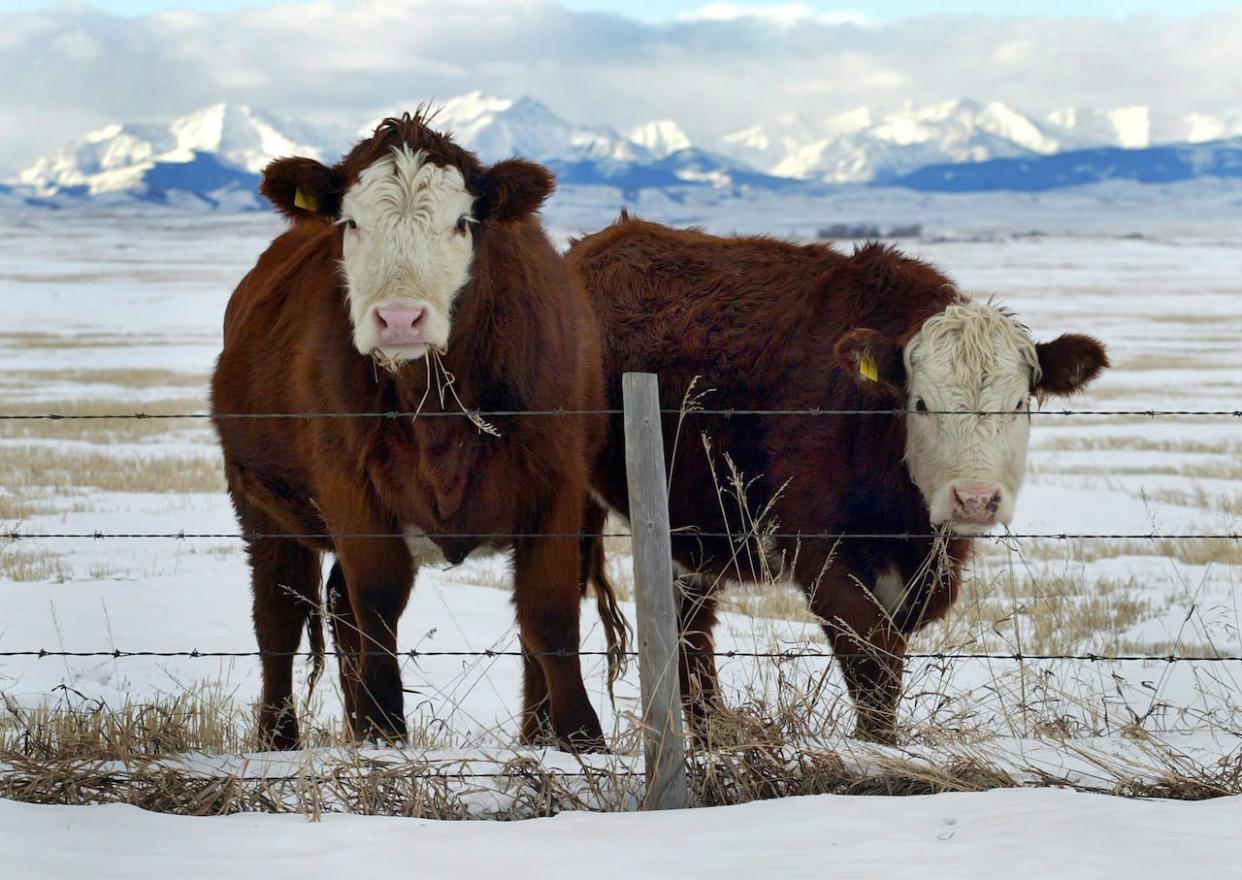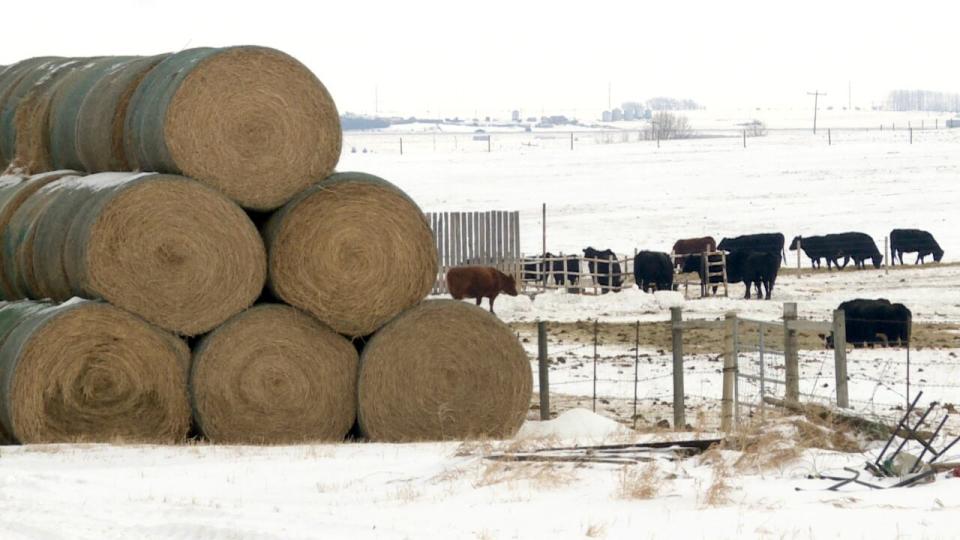Beef prices may be high, but that doesn't equal big profits for ranchers

Graham Overguard, who ranches 230 cow-calf pairs northwest of Sundre, is wondering whether he'll have enough hay to feed his herd next year.
As this summer's drought stretches into an unseasonably warm and dry winter, feed for Alberta's cattle herd is scarce and expensive.
Combine that with the cost of fuel and other inputs, and many of the province's ranchers are facing tough decisions about how many animals they can realistically support into the new year.
Overguard, for one, is surrounded by reminders of what's at stake.
"[For] at least five neighbours within 10 miles of my operation, this has been their last year raising cows, and these are all multi-generational farms," he said.
"It's extremely hard to make a profit."
Projections by CanFax, a division of the Canadian Cattle Association that tracks market data, show Alberta's cow herd shrinking again this year, following last year's trend.
Brenna Grant, CanFax's executive director, said those numbers are primarily driven by drought.
"There are some regions that have gotten rain and have been able to replenish pasture conditions and feed supplies, but other areas continue to have a deficit of soil moisture."
Grant added that the number of cows being sent to slaughter is up, another indication that ranchers are choosing to downsize their herd in the midst of feed uncertainty and capitalize on high beef prices.
But even if they are able to cash in, rebuilding those herds could take years, if they ever decide to go back down that road.
Grant said the shrinking Albertan cow herd is a part of the regular boom and bust of the larger North American cattle market, which has seen the United States also go through a period of liquidating herds. But because of the ongoing drought, Grant acknowledges it could take longer for markets to correct.
"We're expecting a flatter bottom to this cattle cycle for a longer time, with tighter supplies before expansion, and expansion can be anywhere between five and seven years," said Grant.
"It's going to take time to recover from this drought and improve soil moisture conditions."
Turning point?
While the wax and wane of Alberta's cow herd may be a longstanding pattern, the squeeze facing ranchers right now could point to a larger disruption.
Overguard, who is also the president of the Western Stock Growers Association, said he doesn't think feed will become more affordable any time soon.
"Five years ago … you could probably find the round bales between $40 and $60. A lot of people [now] are paying well over $100 per bale. I don't think we'll ever see round bales selling for less than [that] again."
That's assuming there are even bales to buy. It's not only drought that's impacting the supply of feed but also competition from producers in the United States.
"Two out of the last three years have been very dry, and the [U.S.] has had dry years as well," said Overguard.

Hay has doubled in price since last year, says Leigh Anderson, a senior economist with Farm Credit Canada. (Dave Gilson/CBC)
He said this means producers from the States have been buying up feed in Alberta early in the season, before local operations have had time to liquidate and buy feed themselves.
This, combined with the cost of other inputs, has put producers in a difficult position.
"[In the past] we've had problems and disease, but lately with inflation … the fuel, the fertilizer, the parts and the equipment — it's crazy," said Overguard.
"And if you're trying to stay up to date with modern techniques and efficiencies and herd health programs, it's very expensive."
Leigh Anderson, senior economist with Farm Credit Canada (FCC), said it's still too soon to tell whether or not current pressures facing farmers mark a turning point.
"We'll have to wait for the actual inventory numbers to come out on cattle in the new year and also the cows and heifers entering feedlots and slaughter, [to see] what the data starts to show for a trend there," said Anderson.
In its 2023 Cattle and Hog Outlook, published at the end of October, FCC projects a positive lookout for the Canadian cattle sector, despite acknowledging a shrinking national cow herd.
"We've seen cattle prices increase over 30 per cent, and even 50 per cent, from their five-year averages," said Anderson.
"So we're really seeing strong demand."
In the face of higher grocery bills, consumer spending on beef also hasn't seemed to falter drastically, said Anderson.
"The demand still is actually relatively strong given where prices are at. But it is, of course, on top of every producer's mind what consumers are going to respond to in a high food inflationary environment."
Anderson said ongoing drought and feed availability will ultimately impact what FCC's positive outlook means for producers in the coming year.
"While the strong prices we're seeing now are normally associated with heifer retention and herd rebuilding efforts, the dryness across the U.S. Midwest and the Canadian Prairies has prompted increased herd liquidation since 2021," reads the FCC's latest report.
Anderson said hay prices have increased close to 50 per cent from a year ago, and have doubled since 2020.
"[Also] on the radar is, of course, the El Niño for 2024, and that [there] could be another year of dryness. So that's probably in the back of the minds of a lot of producers."
Other forms of income
Overguard said that while the latest instalment of the federal AgriRecovery program — designed to offer relief to livestock producers affected by drought — has helped, the rollout of the funds could be improved.
"It's better than a kick in the head with a frozen boot, but when these things happen, we need [the money] in August, or early September."
Overguard said that at times, financial support doesn't reach farmers until later in the season, when it's too late to buy feed anyways.
"If you're going to buy 500 bales off your neighbour, it's pretty hard to tell them, 'OK, well you'll get the money as soon as I do,' and then not know when the money [is going to show] up."
In order to make ends meet, Overguard said, producers will have to find other streams of revenue to support their operations.
For example, he works full-time running a trucking company.
"Everybody that's my age, and I'm 37, has outside revenue of some sort."

